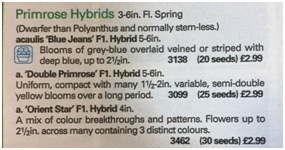
1995 purchase of Primula ‘Blue Jeans’ leads to discovery of supergene

Research involving primula seed from a packet purchased from the 1995 Thompson & Morgan catalogue has resulted in the identification of a cluster of genes responsible for reproductive characteristics in flowers noted by Charles Darwin over 150 years ago.
Darwin noticed that some plant species with two distinct forms of flower, where male and female reproductive organs were of differing lengths, had evolved that way to promote ‘out-crossing’ by insect pollinators. ‘Out-crossing’ is the process whereby plants are pollinated by pollen from a different plant of the same species. The process of ‘out-crossing’ means that genetic diversity is increased, which reduces the possibility of the plant being subject to disease or genetic abnormalities.
Professor Phil Gilmartin from the School of Biological Sciences at the University of East Anglia (UEA) has been involved in the research of heterostyly - the term given to Darwin’s insight into the significance of the two distinct forms of flower - for a large part of his career. His team has recently announced a major scientific breakthrough: they have identified exactly which part of these species’ genetic code made them that way.
In a press release dated 2nd December 2016, Professor Gilmartin says: "This study answers some of the crucial questions that have been asked since Darwin’s time, and for me since I bought my first packet of Primula seeds twenty years ago".

Prof. Gilmartin tweeted Thompson & Morgan to say that his discovery had all started with a packet of Primula seeds that he had bought from the seed merchants’ 1995 catalogue - and he added a photo of the catalogue’s now worn front cover. In a conversation with Prof. Gilmartin, it was established that the variety in question was Primula ‘Blue Jeans’. He said that the choice of this particular F1 Hybrid Primula variety was pivotal as it gave a very homogenous parent line on which to base his research on.

Researchers mapped the plant’s genes and sequenced the Primula genome to find the specific gene cluster responsible for creating the differing flower forms. Prof. Gilmartin said that this insight has profound implications for our understanding of a key evolutionary innovation of flowering plants.
The research - and discoveries such as this latest breakthrough - by scientists such as the UEA team are vital to understanding the mechanism of pollination. The more we understand the genetics which underpin the development of flowers and the reproduction of different species, the more we can discover about the entire system of pollination, which in turn strengthens our understanding of biodiversity and food security - both topical issues.
Professor Gilmartin added: "With challenges such as climate change and its effects on plants, crops and their insect pollinators, it’s even more important to understand the pollination mechanisms and how species can and will react".
View Primula Products
Other Quick Links
Written by: Sonia Mermagen
Although I love beautiful plants and gardens, I am a self-proclaimed ‘reluctant’ gardener and 
am generally amazed if anything flourishes in my own garden.
I'm a big fan of plants marked ‘easy to grow’, ‘drought tolerant’ and ‘no pruning necessary’ and have had some success over the years with Buddleja ‘Buzz’, Lily ‘Defender’ and Lavender ‘Munstead’. I do enjoy a small, but very tasty annual crop of blueberries from my lone blueberry plant.
Sign Up For Exclusive Special Offers




© 2024 Thompson & Morgan. All rights reserved. A division of Branded Garden Products Limited.



